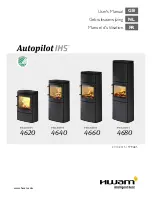
3.5 Stoking
As soon as the stove has warmed up (after about 15 minutes) the incineration can be controlled. The
following points are important:
• The primary aeration can be closed. This additional full air supply is only required during the lighting
of the stove. Push the ashtray completely into the stove.
Continuous stoking with the primary air supply
open causes a fiercely white-hot fire that can damage the stove. Prevent white glow and over-firing.
• The secondary aeration provides the stove with the SGI system. This should never be fully closed
during the incineration, in order to prevent soot on the windows. In addition this slide allows for the
provision of less or more air.
• The tertiary aeration controls the afterburning process. This aeration ensures that the unburnt gasses,
emerging from the wood, are provided with additional oxygen. At higher temperatures, up from
± 550°C these gasses are additionally afterburnt. This considerably improves the efficiency of the
stove. This aeration is not adjustable and is always fully opened.
• When controlling the incineration it is important that there will be no incomplete incineration. An
incomplete incineration occurs if oxygen is supplied insufficiently, due to the fact that the primary,
secondary and tertiary air supply controllers have been closed too soon. An incomplete incineration
can be identified by:
- An increase of smoke development in the incineration compartment;
- The fire going out;
- Soot on the window.
The flue from the chimney also tells something about the incineration: white or colorless smoke
indicates a proper incineration. If the smoke is grey, grey blue or black, the incineration is incomplete.
Avoid overloading (white burning glow), caused by lengthy burning with primary air fully open or by
burning too much wood in one go. The stove can then become overheated. This may damage the stove.
3.6 Optimal stoking
Burning with wood is highly environmentally responsible and also most efficient if you have a hot but
quietly burning fire. The ash should mildly glow red and orange, and should certainly not be glowing as
bright as a blacksmith’s fire. A solid fire burns fast and fiercely which allows no time for full incineration.
You achieve maximum efficiency if:
• You don’t burn during foggy and windless weather.
• You make sure that you use pure dry wood.
• You only burn with the door closed. This increases the temperature in the incineration compartment,
which leads to better incineration.
• You take care of a regular incineration. To this end you burn with a completely closed primary air
regulation. The ashtray is completely sealed. Fully open the secondary aeration by pushing the tube
above the door completely into the stove. The tertiary aeration is not adjustable and it is always fully
opened.
• You ensure there is a significant ash layer (2 to 3 centimeters) on the bottom grid. Not only does this
form protection, it also leads to a significant decrease of the wood consumption and an easier ignition
of the added wood.
• You take care of a homogenous wood bed. Place the blocks loosely, well distributed and horizontally on
the ash bed, separated from each other and a few centimeters away from the walls. This way
the incineration process is able to better obtain the required oxygen.
• In case of a nominal capacity of 7 kW 1,5 kg beech wood suffices for a burning time of about 45
minutes. Refill only when the charcoal phase has been achieved. Keep the door open for a short period
of time during this.
7


































